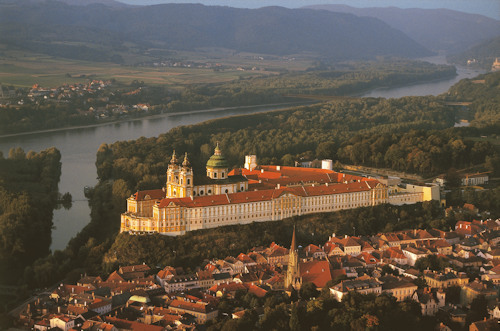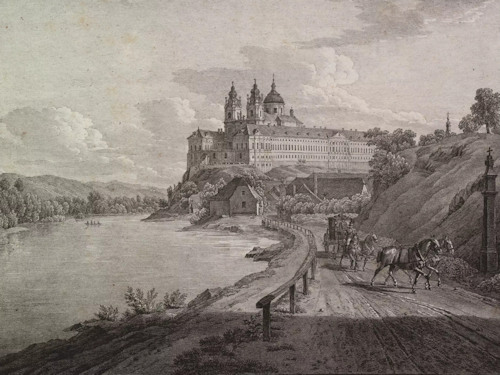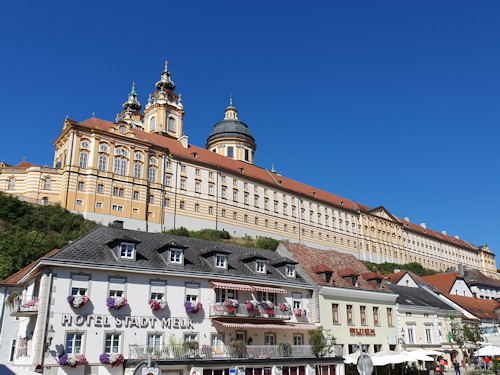
Not that Vienna will admit it, but the rest of the world also has some lovely historical buildings. Some are even an easy day trip away from the city. Like the gorgeous Baroque Benedictine abbey that is Stift Melk.
- Melk easy to reach by train
- Pristine 18th-century architecture
- Full of art & history
- Melk old town worth a walk, too
- Book a tour* leaving from Vienna
- See also:
Stift Melk

(Aerial view of the abbey; press photo by Pater Martin Rotheneder and © Stift Melk)
Approach the small town of Melk in Lower Austria from afar, and you soon see its outstanding historical jewel: Melk Abbey (Stift Melk in German) perches on a hill sandwiched between the Danube valley and the old town.
The view of the abbey from below conveys the sense of a fortress, despite the peaceful decorated façade and church towers.
Indeed, the location was an actual fortification in a previous millennium. (Not the previous millennium, but the one before that!)
Benedictine monks run the abbey now and have done continuously since their arrival in 1089 in the time of Babenberg rule; the Habsburgs would only appear in the area almost two centuries later. So the location has experienced a fair bit of history to say the least.
What you see today largely came about through a major Baroque reconstruction in the 1700s, though two towers remain from those Babenberg days.

(Print of the Benedictine Melk Abbey published in 1826 with the lithograph by Adolf Friedrich Kunike and drawing by Jakob Alt; Wien Museum Inv.-Nr. 105081/89; excerpt reproduced with permission under the terms of the CC0 licence)
That all-in-one reconstruction has left us with the kind of views, rooms, courtyards and corridors that induce open-mouthed awe. And all anchored in a wider cultural landscape that stands on the UNESCO World Heritage list.
So what does a visit reveal?
I’ve taken a detailed look at what you see on a wander around the interior in the Melk abbey tour article, But here a quick overview…
The monastic areas and the attached school remain, of course, off limits. (Over 20 monks still live and work at Melk at the time of writing.) But the parts open to the public in this large complex include:
- Secular staterooms & balcony with views over the town and Danube
- A museum full of historical treasures
- The lovely library and abbey church
- The northern bastion with its own panorama view
- A gardens & park area with a fresco-filled Baroque pavilion
- A mineral collection, and any special exhibitions that might be hosted in the abbey
Everything within feels pristine and well-maintained. All as if time chose to leave this part of the world untouched…merely adding some modern visitor facilities.
The abbey also has a full-blown restaurant, a café out in the garden pavilion, and shops: all a little more upmarket than many historical buildings offer. The stores, in particular, stock the kind of mementoes that double as unique gifts. (I picked up some specialist abbey beer for friends.)
And wider Melk?
The older parts of the town below also deserve attention, especially the line of streets immediately at the bottom of the hill (Stiftsweg along to the Rathausplatz, then up Hauptstraße and across the Hauptplatz and down Kremser Straße to the river).
That route offers ample opportunity for great photos of the abbey above. In particular, cross over the river using the bridge at the end of Kremser Straße for a gorgeous view of the western end.
Most of the buildings you see on the way date back to long before IKEA was a thing, to even as far as the 1400s.

(View from the Melk old town)
The walk also takes you past numerous small regional shops and places to eat and drink, ready to serve abbey visitors but also the many cyclists that stop off (or over) here on their way along the Danube.
We had lovely coffee and cake (without paying tourist prices) at the Bäckerei Konditorei Mistelbacher at Hauptstraße 1, for example.
Tickets & tips
Melk abbey opens to the public year round.
Shop(s), the restaurant, the entrance courtyard and the landscaped approach require no ticket. But most of the complex needs a ticket (or tour participation) to view.
Having said that, access to the paid areas in some off-season days and months is only possible if you are on a guided tour.
At the time of writing, a standard adult entrance ticket for the 2024 season (without a tour) costs €16.
Incidentally, the abbey offers their own English or multilingual tours up to three times a day, depending on the season.
Another strong option is a guided excursion that leaves from Vienna.
This tour*, for example, takes you down the Danube valley and around the abbey, with either a stop in picturesque Krems or Dürnstein or a boat trip down the river (depending on the season).
If Melk catches your interest, you might also like to visit Klosterneuburg: the town actually borders Vienna and also has its own magnificent abbey.
How to get to Melk Abbey
If you’re not taking a tour bus/boat from Vienna, then the best choice for self-guided trips is a train from Vienna. Three or four typically leave each hour. The walk from Melk station to the abbey takes about ten minutes (mostly uphill, of course).
- Trains to & from the relatively central Wien Westbahnhof station (on the U3 and U6 subway lines) travel direct and usually reach Melk in just over an hour.
- Services to & from the big Wien Hauptbahnhof station can take as little as 53 minutes but involve changing trains once.
The abbey also has a large car park with tree shade, which is free to use if you buy an entrance ticket (show your parking ticket at the counter when you purchase your tickets).
Address: Stift Melk, Abt-Berthold-Dietmayr-Str. 1, 3390 Melk | Website